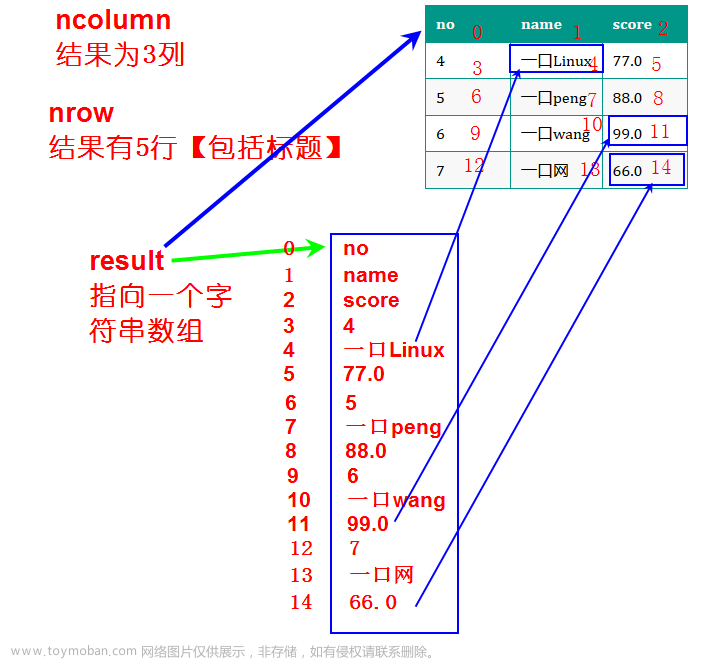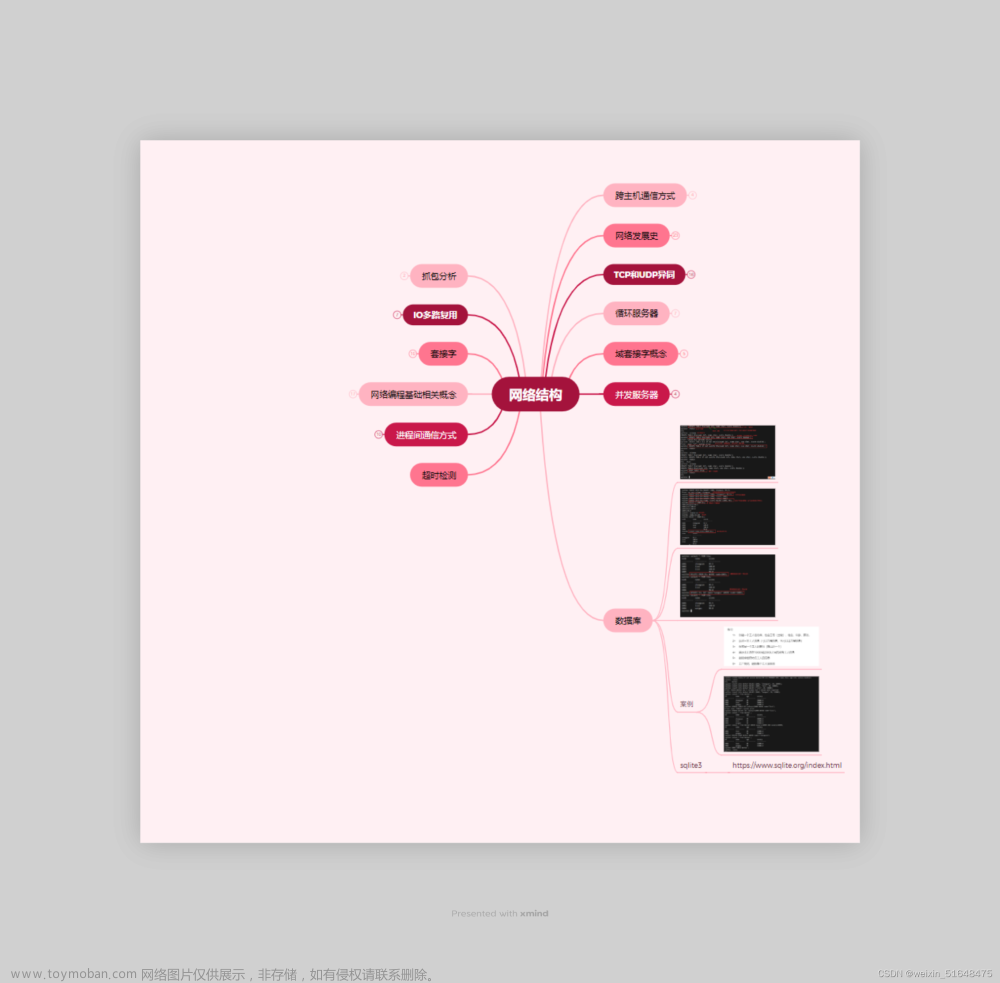目录
一.数据库基本概念(理解)
1.数据
2.数据库
二.常用的数据的数据库(了解)
1.大型数据库
2.中型数据库
3.小型数据库
三.基于嵌入式的数据库(了解)
四.SQLite基础(了解)
五.创建数据库(熟练)
1.手工创建
2.代码创建
六.SQLite编程接口
七.代码示例(学生管理系统)
八.水果店铺管理系统
一.数据库基本概念(理解)
1.数据
能够输入计算机并能够计算机程序识别和处理的信息集合。(不只是数字)
2.数据库
数据库是在数据库管理系统管理和控制之下,存放在存储介质上的数据集合。
二.常用的数据的数据库(了解)
1.大型数据库
Oracle公司是最早开发关系数据库的厂商之一,其产品支持最广泛的操作系统平台。目前Oracle关系数据库产品的市场占有率名列前茅。 IBM 的DB2是第一个具备网上功能的多媒体关系数据库管理系统,支持包Linux在内的一系列平台。
2.中型数据库
Server是微软开发的数据库产品,主要支持windows平台。
3.小型数据库
mySQL是一个小型关系型数据库管理系统,开发者为瑞典MySQL AB公司,2008年被Sun公司收购,开放源码。
三.基于嵌入式的数据库(了解)
基于嵌入式Linux的数据库主要有SQLite, Firebird, Berkeley DB, eXtremeDB
Firebird是关系型数据库,功能强大,支持存储过程、SQL兼容等
SQLite关系型数据库,体积小,支持ACID事务
Berkeley DB中并没有数据库服务器的概念,它的程序库直接链接到应用程序中
eXtremeDB是内存数据库,运行效率高
四.SQLite基础(了解)
SQLite的源代码是C,其源代码完全开放。SQLite第一个Alpha版本诞生于2000年5月。 他是一个轻量级的嵌入式数据库。
SQLite有以下特性:
零配置一无需安装和管理配置;
储存在单一磁盘文件中的一个完整的数据库;
数据库文件可以在不同字节顺序的机器间自由共享;
支持数据库大小至2TB;
足够小,全部源码大致3万行c代码,250KB;
比目前流行的大多数数据库对数据的操作要快;
五.创建数据库(熟练)
1.手工创建
使用SQLite3工具,通过手工输入SQL命令行完成数据库创建. 用户在Linux的命令行界面中输入SQLite3可启动SQLite3工具
数据库的安装
sudo dpkg -i *.deb //本地安装包安装
sudo apt-get install sqlite3 //在线安装数据库常用命令
(1) 系统命令都以“ . ”开头
.exit //退出
.quit //退出
.table //查看表
.schema <table_name> //查看表的结构
.help //显示所有命令
.database //显示当前打开的数据库文件
打开数据库文件
在终端下运行sqlite3 <*.db>,出现如下提示符
SQLite version 3.7.2
Enter “.help” for instructions
Enter SQL statements terminated with a “;”
sqlite>
<*.db> 是要打开的数据库文件。若该文件不存在,则自动创建
(2)sql执行语句,都以“ ;”结尾
创建一张表
create table <table_name> (f1 type1, f2 type2,…);
crerate table stuinfo(id integer ,name char ,age intger,score float);插入一条记录
insert into <table_name> values (value1, value2,…);
insert into stuinfo values(1001, 'zhangsan', 18, 80);
insert into stuinfo (id, name, score) values(1002, 'lisi', 90);查看数据库记录(where后面是条件)
select * from <table_name> where <expression>;
select * from stuinfo;
select * from stuinfo where score = 80;
select * from stuinfo where score = 80 and name= 'zhangsan';
select * from stuinfo where score = 80 or name='wangwu';
select name,score from stuinfo; 查询指定的字段
select * from stuinfo where score >= 85 and score < 90;删除一条记录
sqlite>delete from <table_name> where <expression>;
delete from stuinfo where id=1003 and name='zhangsan';更新一条记录
sqlite>update <table_name> set <f1=value1>, <f2=value2>… where<expression>;
update stuinfo set age=20 where id=1003;
update stuinfo set age=30, score = 82 where id=1003;删除一张表
drop table <table_name>
drop table stuinfo;增加一列
alter table <table> add column <field> <type> default …;
alter table stuinfo add column sex char;删除一列(通过创建新的表来删除)
create table stu as select id, name, score from stuinfo;
drop table stuinfo;
alter table stu rename to stuinfo;2.代码创建
在程序运行过程中,当需要进行数据库操作时,应用程序会首先尝试打开数据库,此时如果数据库并不存在,程序则会自动建立数据库,然后再打开数据库
六.SQLite编程接口
1.打开(创建)sqlite数据库
int sqlite3_open(char *path, sqlite3 **db);
path:数据库文件路径(数据库名称)
db:指向sqlite句柄的指针
返回值:成功返回0,失败返回错误码(非零值)
2.关闭sqlite数据库
int sqlite3_close(sqlite3 *db);
返回值:成功返回0,失败返回错误码
3.得到错误信息的描述
const char *sqlite3_errmg(sqlite3 *db);
返回值:返回错误信息
4.执行SQL语句操作
Int sqlite3_exec(
sqlite3 *db,
const char *sql,
sqlite3_callback callback,
void *, char **errmsg
);
db:数据库句柄
sql:SQL语句
callback:回调函数
errmsg:错误信息指针的地址
返回值:成功返回0,失败返回错误码
/* Callback function */
功能:查询语句执行之后,会回调此函数
查询回调函数:
int (*callback)(void* arg,int ncolumns ,char** f_value,char** f_name);
参数:arg 接收sqlite3_exec 传递来的参数
ncolumns 列数(记录中包含的字段数目)
f_value 列的值的地址(包含每个字段值的指针数组)
f_name 列的名称(包含每个字段名称的指针数组)
返回值:成功返回0,失败返回-1
5. 不使用回调函数执行SQL操作查询
不使用回调函数执行SQL语句
int sqlite3_get_table(sqlite3 *db, const char *sql, char ***resultp, int*nrow, int *ncolumn, char **errmsg);
db:数据库句柄
sql:SQL语句
resultp:用来指向sql执行结果的指针
nrow:满足条件的记录的数目
ncolumn:每条记录包含的字段数目
errmsg:错误信息指针的地址
返回值:成功返回0,失败返回错误码
七.代码示例(学生管理系统)
管理学生的信息文章来源:https://www.toymoban.com/news/detail-704104.html
八.水果店铺管理系统
管理水果种类,重量,价格等信息和信息变动记录文章来源地址https://www.toymoban.com/news/detail-704104.html
#include <stdio.h>
#include <stdlib.h>
#include <string.h>
#include <sqlite3.h>
#include <time.h>
#define DATABASE "fruit.db"
#define TABLES "fruit"
#define N 128
int do_insert(sqlite3 *db,char *buf);
int do_update_weight(sqlite3 *db,char *buf);
int do_update_price(sqlite3 *db);
int do_query(sqlite3 *db);
int callback(void *arg, int f_num, char ** f_value, char ** f_name);
int main(int argc, const char *argv[])
{
sqlite3 *db;
char *errmsg;
int n;
char sql[128] = {};
char buf[128] = {};
time_t t;
struct tm *tp;
if(sqlite3_open(DATABASE, &db) != SQLITE_OK)
{
printf("%s\n", sqlite3_errmsg(db));
return -1;
}
else
{
printf("open DATABASE success.\n");
}
sprintf(sql,"create table if not exists '%s' (id integer primary key autoincrement,name char,weight float,price float,time char);",TABLES);
if(sqlite3_exec(db, sql,NULL, NULL, &errmsg) != SQLITE_OK)
{
printf("%s\n", errmsg);
}
else
{
printf("Create or open table success.\n");
}
time(&t);
tp = localtime(&t);
sprintf(buf,"%d-%02d-%02d %02d:%02d:%02d\n",tp->tm_year+1900, tp->tm_mon+1,tp->tm_mday, tp->tm_hour, tp->tm_min, tp->tm_sec);
printf("%s",buf);
while(1)
{
puts("-----------------------------------------");
do_query(db);
puts("-----------------------------------------");
puts("");
printf("********************************************\n");
printf("1: insert 插入 2:query 查询 3:trade 交易 4:update 更新 5:quit 退出系统\n");
printf("********************************************\n");
printf("Please select:");
scanf("%d", &n);
switch(n)
{
case 1:
do_insert(db,buf);
break;
case 2:
do_query(db);
break;
case 3:
do_update_weight(db,buf);
break;
case 4:
do_update_price(db);
break;
case 5:
printf("main exit.\n");
sqlite3_close(db);
exit(0);
break;
default :
printf("Invalid data n.\n");
}
}
return 0;
}
int do_insert(sqlite3 *db,char *buf)
{
char name[32] = {};
float weight;
float price;
char sql[N] = {};
char *errmsg;
printf("Input fruit name:");
scanf("%s", name);
getchar();
printf("Input weight:");
scanf("%f", &weight);
printf("Input price:");
scanf("%f", &price);
sprintf(sql, "insert into '%s' (name,weight,price,time)values('%s', '%.3f', '%.3f','%s')",TABLES, name, weight, price,buf);
if(sqlite3_exec(db, sql, NULL, NULL, &errmsg) != SQLITE_OK)
{
printf("%s\n", errmsg);
}
else
{
printf("Insert done.\n");
}
return 0;
}
int do_update_weight(sqlite3 *db,char *buf)
{
int id;
char sql[N] = {};
char *errmsg;
float weight;
printf("Input id:");
scanf("%d", &id);
printf("Input weight:");
scanf("%f", &weight);
sprintf(sql, "update '%s' set weight='%f',time='%s' where id=%d",TABLES, weight,buf,id);
if(sqlite3_exec(db, sql, NULL, NULL, &errmsg) != SQLITE_OK)
{
printf("%s\n", errmsg);
}
else
{
printf("Delete done.\n");
}
return 0;
}
int do_update_price(sqlite3 *db)
{
float price;
int id;
char sql[N] = {};
char *errmsg;
printf("Input id:");
scanf("%d", &id);
printf("Input alter price:");
scanf("%f", &price);
sprintf(sql, "update '%s' set price='%f' where id=%d",TABLES , price,id);
if(sqlite3_exec(db, sql, NULL, NULL, &errmsg) != SQLITE_OK)
{
printf("%s\n", errmsg);
}
else
{
printf("update done.\n");
}
return 0;
}
int callback(void *arg, int f_num, char ** f_value, char ** f_name)
{
int i = 0;
for(i = 0; i < f_num; i++)
{
// printf("%-8s %s", f_value[i], f_name[i]);
printf("%-8s", f_value[i]);
}
putchar(10);
puts("-----------------------------------------");
return 0;
}
int do_query(sqlite3 *db)
{
char *errmsg;
char sql[N] = {};
sprintf(sql,"select * from '%s';",TABLES);
if(sqlite3_exec(db, sql, callback,NULL , &errmsg) != SQLITE_OK)
{
printf("%s", errmsg);
}
else
{
printf("select done.\n");
}
return 0;
}到了这里,关于【嵌入式数据库之sqlite3】的文章就介绍完了。如果您还想了解更多内容,请在右上角搜索TOY模板网以前的文章或继续浏览下面的相关文章,希望大家以后多多支持TOY模板网!












